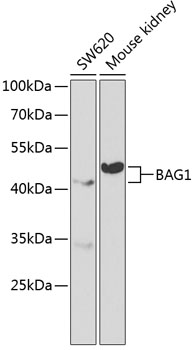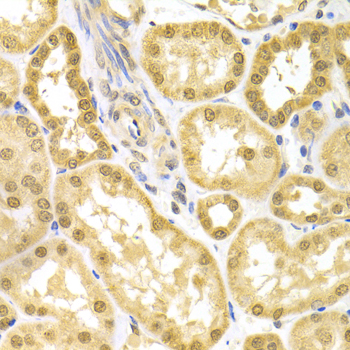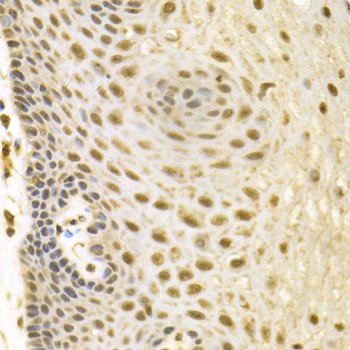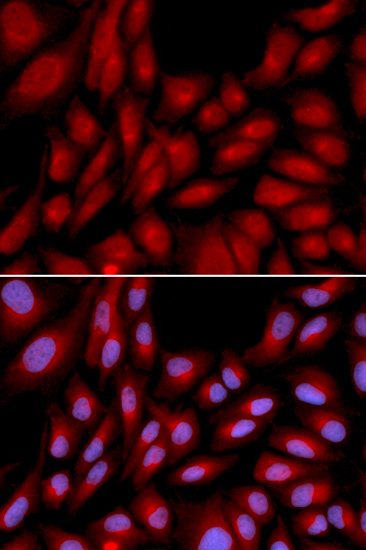Cell Death Antibodies 1
Anti-BAG1 Antibody (CAB1104)
- SKU:
- CAB1104
- Product Type:
- Antibody
- Reactivity:
- Human
- Reactivity:
- Mouse
- Host Species:
- Rabbit
- Isotype:
- IgG
- Antibody Type:
- Polyclonal Antibody
- Research Area:
- Cell Death
Description
| Antibody Name: | Anti-BAG1 Antibody |
| Antibody SKU: | CAB1104 |
| Antibody Size: | 20uL, 50uL, 100uL |
| Application: | WB IHC IF |
| Reactivity: | Human, Mouse |
| Host Species: | Rabbit |
| Immunogen: | Recombinant fusion protein containing a sequence corresponding to amino acids 1-230 of human BAG1 (NP_001165886.1). |
| Application: | WB IHC IF |
| Recommended Dilution: | WB 1:500 - 1:2000 IHC 1:50 - 1:200 IF 1:20 - 1:100 |
| Reactivity: | Human, Mouse |
| Positive Samples: | SW620, Mouse kidney |
| Immunogen: | Recombinant fusion protein containing a sequence corresponding to amino acids 1-230 of human BAG1 (NP_001165886.1). |
| Purification Method: | Affinity purification |
| Storage Buffer: | Store at -20'C. Avoid freeze / thaw cycles. Buffer: PBS with 0.02% sodium azide, 50% glycerol, pH7.3. |
| Isotype: | IgG |
| Sequence: | MNRS QEVT RDEE STRS EEVT REEM AAAG LTVT VTHS NEKH DLHV TSQQ GSSE PVVQ DLAQ VVEE VIGV PQSF QKLI FKGK SLKE METP LSAL GIQD GCRV MLIG KKNS PQEE VELK KLKH LEKS VEKI ADQL EELN KELT GIQQ GFLP KDLQ AEAL CKLD RRVK ATIE QFMK ILEE IDTL ILPE NFKD SRLK RKGL VKKV QAFL AECD TVEQ NICQ ETER LQST NFAL AE |
| Gene ID: | 573 |
| Uniprot: | Q99933 |
| Cellular Location: | Cytoplasm, Cytoplasm, Nucleus |
| Calculated MW: | 25kDa/31kDa/34kDa/38kDa |
| Observed MW: | 43kDa |
| Synonyms: | BAG1, BAG-1, HAP, RAP46 |
| Background: | The oncogene BCL2 is a membrane protein that blocks a step in a pathway leading to apoptosis or programmed cell death. The protein encoded by this gene binds to BCL2 and is referred to as BCL2-associated athanogene. It enhances the anti-apoptotic effects of BCL2 and represents a link between growth factor receptors and anti-apoptotic mechanisms. Multiple protein isoforms are encoded by this mRNA through the use of a non-AUG (CUG) initiation codon, and three alternative downstream AUG initiation codons. A related pseudogene has been defined on chromosome X. |
| UniProt Protein Function: | BAG1: Inhibits the chaperone activity of HSP70/HSC70 by promoting substrate release. Inhibits the pro-apoptotic function of PPP1R15A, and has anti-apoptotic activity. Markedly increases the anti-cell death function of BCL2 induced by various stimuli. Homodimer. Forms a heteromeric complex with HSP70/HSC70. Binds to the ATPase domain of HSP/HSC70 chaperones. Isoform 1, isoform 3 and isoform 4 but not isoform 2 interact with HSPA8/HSC70. Interacts with NR3C1. Interacts with the N-terminal region of STK19. Interacts with PPP1R15A. Interacts with BCL2 in an ATP-dependent manner. Isoform 2 does not interact with BCL2. Up-regulated during differentiation of bladder epithelial cells and down-regulated during differentiation of prostate epithelium. Isoform 4 is the most abundantly expressed isoform. It is ubiquitously expressed throughout most tissues, except the liver, colon, breast and uterine myometrium. Isoform 1 is expressed in the ovary and testis. Isoform 4 is expressed in several types of tumor cell lines, and at consistently high levels in leukemia and lymphoma cell lines. Isoform 1 is expressed in the prostate, breast and leukemia cell lines. Isoform 3 is the least abundant isoform in tumor cell lines. 4 isoforms of the human protein are produced by alternative splicing. |
| UniProt Protein Details: | Protein type:Nuclear receptor co-regulator; Motility/polarity/chemotaxis Chromosomal Location of Human Ortholog: 9p12 Cellular Component: cytoplasm; nucleus Molecular Function:protein binding; chaperone binding; receptor signaling protein activity Biological Process: cell surface receptor linked signal transduction; apoptosis; negative regulation of apoptosis |
| NCBI Summary: | The oncogene BCL2 is a membrane protein that blocks a step in a pathway leading to apoptosis or programmed cell death. The protein encoded by this gene binds to BCL2 and is referred to as BCL2-associated athanogene. It enhances the anti-apoptotic effects of BCL2 and represents a link between growth factor receptors and anti-apoptotic mechanisms. Multiple protein isoforms are encoded by this mRNA through the use of a non-AUG (CUG) initiation codon, and three alternative downstream AUG initiation codons. A related pseudogene has been defined on chromosome X. [provided by RefSeq, Feb 2010] |
| UniProt Code: | Q99933 |
| NCBI GenInfo Identifier: | 296439462 |
| NCBI Gene ID: | 573 |
| NCBI Accession: | Q99933.4 |
| UniProt Secondary Accession: | Q99933,O75315, Q14414, Q53H32, Q5VZE8, Q5VZE9, Q5VZF0 Q96TG2, Q9Y2V4, |
| UniProt Related Accession: | Q99933 |
| Molecular Weight: | 345 |
| NCBI Full Name: | BAG family molecular chaperone regulator 1 |
| NCBI Synonym Full Names: | BCL2-associated athanogene |
| NCBI Official Symbol: | BAG1 |
| NCBI Official Synonym Symbols: | HAP; BAG-1; RAP46 |
| NCBI Protein Information: | BAG family molecular chaperone regulator 1; Bcl-2-binding protein; receptor-associated protein, 46-KD; Bcl-2 associating athanogene-1 protein; glucocortoid receptor-associated protein RAP46 |
| UniProt Protein Name: | BAG family molecular chaperone regulator 1 |
| UniProt Synonym Protein Names: | Bcl-2-associated athanogene 1 |
| Protein Family: | BAG family molecular chaperone regulator |
| UniProt Gene Name: | BAG1 |
| UniProt Entry Name: | BAG1_HUMAN |
View AllClose








![Anti-Caspase-3 Antibody (CAB11040)[KO Validated] Anti-Caspase-3 Antibody (CAB11040)[KO Validated]](https://cdn11.bigcommerce.com/s-rd6ounxcu2/images/stencil/590x590/products/39044/43790/anti-caspase-3-antibody-cab11040ko-validated__58469__84506.1706521185.jpg?c=1)


